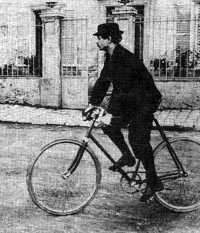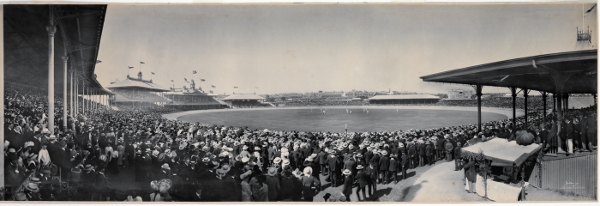In 1899 the steamship Miowera brought strange news from the Australian colonies. The ship made regular trips from Australia to Canada, but this time the sailors brought with them something a little more exotic than ballast and sun-baked tourists. Something had happened in Sydney, they said. Something… evil.
The Australians told the tale of a bicycle race. This was not unusual in itself. Cycling underwent a surge in popularity in the 1890s, resulting in quite the craze for those two-wheeled concerns. This, however, was no ordinary race. This race was won by a dead man. In a one-mile race and in front of 10,000 spectators, a dead man crossed the finish line first. What happened was this. Young cyclist James Somerville got within 25 yards of the finish line when he was seen to relax his hold on the handle-bars. Five yards from the finish the second-place cyclist put on a burst of speed but somehow caught Somerville’s back wheel, propelling our hero over the finish line “like a rocket”. The crowd went wild, but instead of collecting his trophy Somerville pitched head-first onto the track. When the doctors examined him, they discovered he’d suffered a heart attack in the last lap and was dead before he crossed the line.

Stirring stuff, by any standard, but how true? The story entered into urban legend and was repeated several times over the next few years. A 1902 newspaper relates how Somerville cycled the last 50 yards without life, while also telling us of a jockey who died on his horse and a hot-air balloonist who died in the air. The July 1903 edition of Our Young People also recounted Somerville’s tale, only they claimed the race happened sometime within the last twelve months. The continual perversion of details suggested that the story was actually apocryphal. It may even have served as the inspiration for some of Alfred Jarry’s pataphysical epic The Supermale (1902), in which a man dies on a bicycle but continues to pedal: “One can sleep on a bike, so one should be able to die on a bike with no more trouble.”
I was about ready to dismiss the thing as a wonderful shred of myth when I found the unthinkable: a coroner’s inquest from 1899 that ruled James Somerville died of “Injuries accidentally received through falling from a bicycle”. The story looked like it might just be true, but soon the threads began to unravel. Further information from the coroner revealed that Somerville had been injured after falling off his bike in a race at the Sydney Cricket Ground, Moore Park, on the 19th of January. However he didn’t die until the 23rd. This vital fact shot a hole right through the dead-as-he-crossed-the-finish-line theory that the Miowera sailors were so eager to tell.
Soon the whole story became clear. Somerville was a 25-year-old man who was born in Ireland and lived in Goulburn. He was regarded as an up-and-coming new cyclist who already had the makings of a “champion rider” even though he hadn’t been riding for more than 18 months. In January 1899 he came to Sydney for the second in a series of “electric light” races. The craze for cycling coincided with widespread new electric lighting, and it took the public’s fancy to watch night-time cycling races illuminated by the electric floodlights. Somerville competed at the races over several nights, but the race in question took place on the 19th. Somerville did not win — the race was actually won by a man named R. Walne. Somerville didn’t even finish the race. 100 yards from the finish line four people collided in the accident which fatally injured Somerville. Somerville apparently tried to pass the next rider on the outside. His front wheel caught the back wheel of the next rider1 and Somerville fell square on his head onto the asphalt2. Despite a fractured skull Somerville regained consciousness in the casualty room, and for a short time was even reported to be getting better. However it was not to be — Somerville died from his injuries on the morning of the 23rd.

Notes
-
An interesting inversion of the Miowera tale. The Miowera sailors claimed the rider behind collided with Somerville’s back wheel, sending him over the finish line. The Sydney newspaper accounts reveal that Somerville was actually the rider who caught the wheel of the man in front. ↩
-
Other accounts say he collided with a fence. ↩
Bibliography
-
“Accidents to Cyclists”. The Sydney Morning Herald 20 January 1899: 7. Print.
-
Ancestry.com. New South Wales, Australia, Registers of Coroners’ Inquests, 1796-1942 [database on-line]. Ancestry.com Operations Inc. Web. 26 July 2011 <http://search.ancestry.com/search/db.aspx?dbid=1785>.
-
“Death of Somerville”. The Sydney Morning Herald 24 January 1899: 8. Print.
-
“Electric Light Cycle Racing”. The Sydney Morning Herald 20 January 1899: 8. Print.
-
“Feats Performed By Dead Men”. Our Young People 12.1 (July 1903): 148. Print.
-
“Honours Won By Dead Men”. Bruce Herald 34.76 (26 September 1902): 2. Print.
-
“Inquests”. The Sydney Morning Herald 25 January 1899: 4. Print.
-
Jarry, Alfred. The Supermale. Trans. Ralph Gladstone & Barbara Wright. Cambridge: Exact Change, 1999. Print.
-
State Library of New South Wales. “Miowera (merchant ship)”. Manuscripts, oral history & pictures. Web. 26 July 2011 <http://acms.sl.nsw.gov.au/item/itemDetailPaged.aspx?itemID=456334>.
State Library of New South Wales. “Panorama of Test Cricket at the Sydney Cricket Ground, 1903 / by Melvin Vaniman”. Manuscripts, oral history & pictures. Web. 26 July 2011 <http://acms.sl.nsw.gov.au/item/itemDetailPaged.aspx?itemID=412352>.
- “Won By A Dead Man”. Dubuque Daily Herald 25 February 1899: 1. Print.